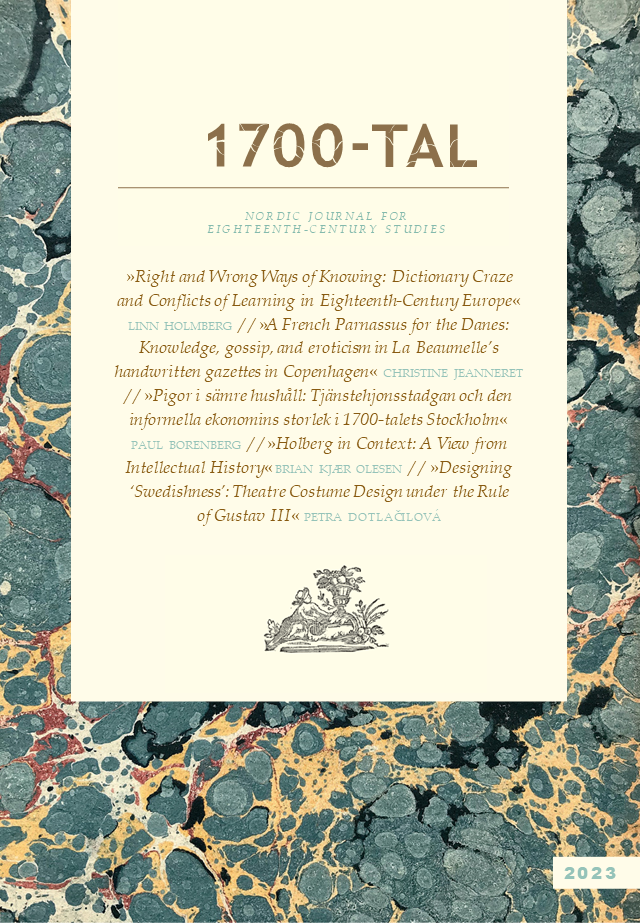Pigor i sämre hushåll
Tjänstehjonsstadgan och den informella ekonomins storlek i 1700-talets Stockholm
DOI:
https://doi.org/10.7557/4.6894Keywords:
Servants, Stockholm, Demography, Informal economy, LabourAbstract
The Swedish Servant Acts compulsed everyone without an occupation to take up service as a servant. However it is unclear to what extent this compulsion was actually enforced. Repeated complaints from the authorities give the impression that it was largely ignored. One suspicion was that people chose to live with relatives rather than taking service. A list compiled by the Stockholms authorities enables a quantification of mostly women who evaded service around 1755. The study shows that up to a fifth of all female servants were suspected of being live ins rather than employed as servants, and most of them problably earned their living in the informal sector of the urban economy. A comparison with tax registers reveals that these people were accounted for. In conclusion, while historical scholarship is dependent upon ample source material, this study suggests that a good part of the servant population was recorded in tax registers, but that the nature of their service might not have been properly accounted for, and that many servants provided for themselves on an extensive informal economy of the city which is difficult to quantify.Metrics
References
Bellman, Carl Michael, ”Fredmans epistel 34” i Fredmans Epistlar, Stockholm 1790. http://runeberg.org/fredepis/34.html
Borenberg, Paul, Servants: Power, Status and Opportunity in 18th century Stockholm, Uppsala, opublicerad masteruppsats, 2014. http://uu.diva-portal.org/smash/get/diva2:721948/FULLTEXT01.pdf
Dribe, Martin, och Lundh, Christer, ”People on the Move: Determinants of Servant Migration in Nineteenth-Century Sweden” i Continuity and Change 20:01 (2005) s. 53-91. https://lucris.lub.lu.se/ws/portalfiles/portal/4556827/4407084 https://doi.org/10.1017/S026841600400534X
Hajnal, John, “Two Kinds of PreIndustrial Household Formation System” i Population and Development Review, 8:3, (1982). https://www.jstor.org/stable/1972376#metadata_info_tab_contents https://doi.org/10.2307/1972376
Harnesk, Börje, Legofolk: Dröngar, pigor och bönder i 1700- och 1800-talens Sverige, Umeå, Umeå Studies in the Humanities, 1990.
Lennartsson, Rebecka, Mamsell Bohmans fall: Nattlöperskor I 1700-talets Stockholm, Stockholm, Stockholmia förlag, 2019. https://doi.org/10.33819/kriterium.17
Ling, Sofia, Konsten att försörja sig: kvinnors arbete i Stockholm 1650-1750, Stockholm, Stockholmia förlag, 2016.
Mitterauer, Michael, “Servants and youth” i. Continuity and Change, 5 (1990). https://www.cambridge.org/core/journals/continuity-and-change/article/abs/servants-and-youth/A59D669FB1A62A75B881C9A0D55DFAA4
Phil, Christopher och Ågren, Maria, “Vad är en hustru? Ett begreppshistoriskt bidrag till genushistorien.” i Historisk tidskrift 134:2 2014.
Söderberg, Johan, Jonsson, Ulf och Persson, Christer, A stagnating metropolis: The economy and demography of Stockholm, 1750-1850, Cambridge, Cambridge University Press, 1991.
Uppenberg, Carolina, I husbondens bröd och arbete: kön, makt och kontrakt i det svenska tjänstefolkssystemet 1730-1860, Göteborg, Gothenburg studies in economic history, 2018. https://gupea.ub.gu.se/handle/2077/55921
Utterström, Gustaf, Jordbrukets arbetare: levnadsvillkor och arbetsliv på landsbygden från frihetstiden till mitten av 1800-talet, Stockholm, Tiden förlag, 1957.
Ågren, Maria (red.) Making a living, making a difference: Gender and work in early modern European society, Oxford, Oxford University Press, 2016. https://doi.org/10.1093/acprof:oso/9780190240615.001.0001
Downloads
Published
Issue
Section
License
Copyright (c) 2023 Paul Borenberg

This work is licensed under a Creative Commons Attribution 4.0 International License.









